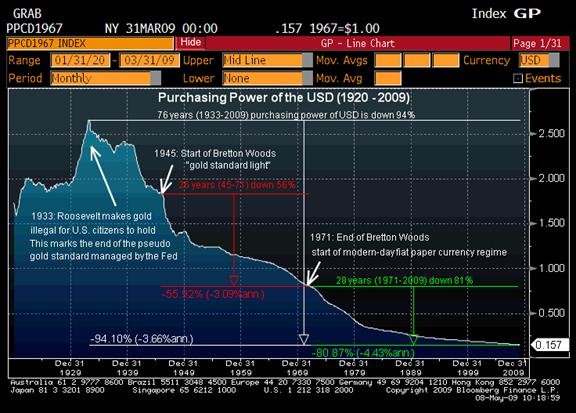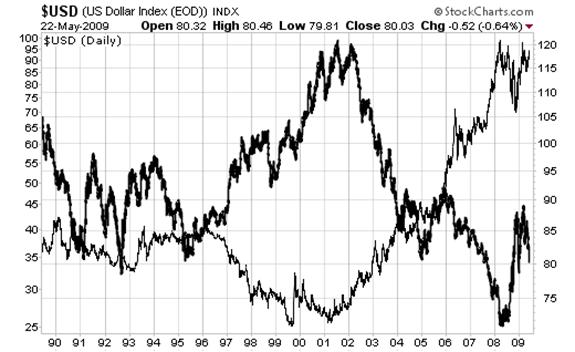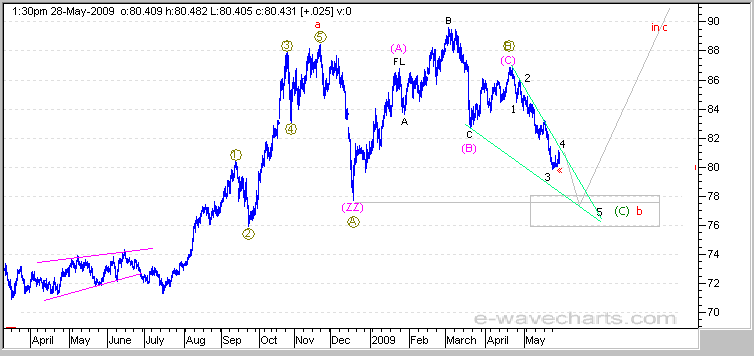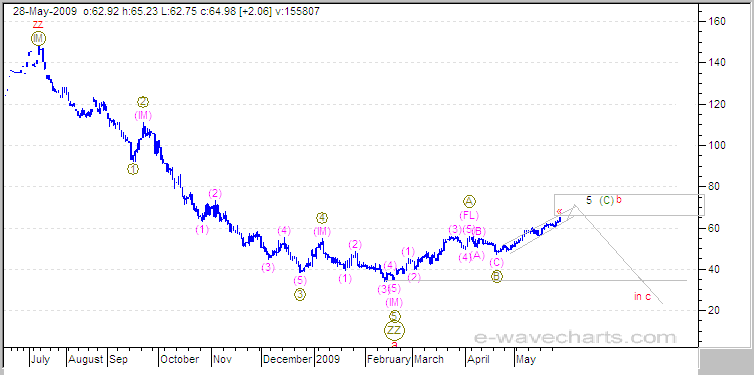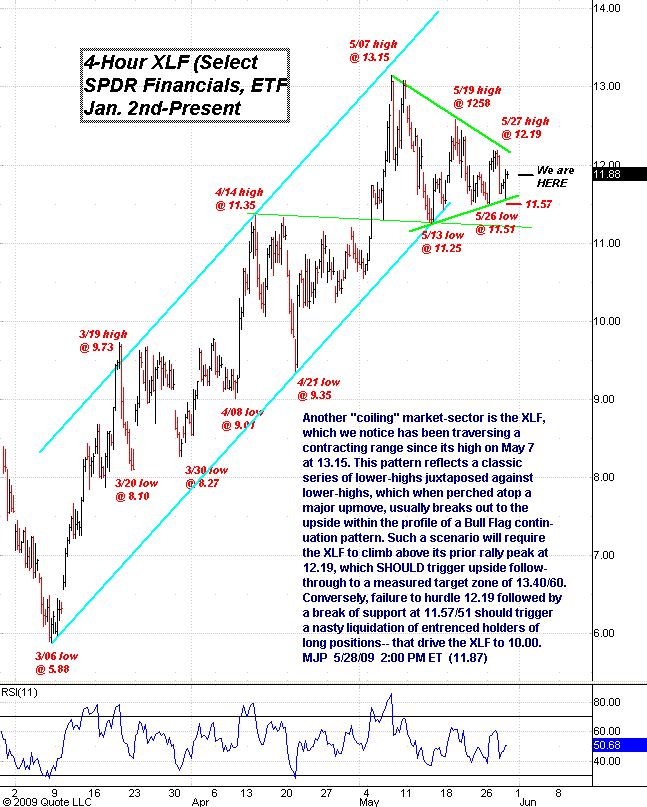While I’ve been lucky enough to identify and forecast a strong rally in global stocks since March, I have made it clear to readers that I don’t think this is anything more than a rally within a bear market.
The higher this rally goes, however, the more you will be hearing that a new bull market has started. But I would not be fooled.
Why do I believe we are simply in a “bear market rally”? I believe this is so because all great starts of bull markets (like the ones in 1949 and 1982) had certain important things in common. In one phrase, these things can be summed up with the words “Great Values.”
When the bull markets started, companies had to offer great dividend yields to investors to entice them to invest. The dividend yield on entire indices was very high.
Second, the price-to-earnings ratio on most stocks, as well as entire indices was very low. Today, I want to focus on the dividend aspect of this idea… and to show you a chart I think every investor should copy, print out, and memorize.
You see, the great thing about a dividend is that is cannot be faked.
Either the check goes out or it does not. Either the company pays a dividend on its stock - a clear and certain dividend - or it does not. Tracking the dividend yield on either a single stock on an entire index is one of the best ways to gauge if stocks are selling at great values.
We have seen time and again that when dividends rise to a certain level, stocks become great bargains and bull markets begin. So let us turn our attention to the chart below. This is the S&P 500 Index (^GSPC: 906.83 0.00 0.00%) and the dividend yield on it, going back to 1928.
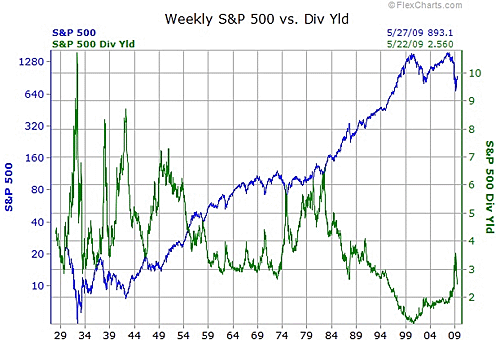
From the start of the chart, you see the horrific loss in value of the S&P (in blue) from 1929 to 1932. The index lost over 90% of its value by the time it reached its lows in July 1932. Nearly three years of the most vicious bear market in history had nearly wiped out stockholders, and made almost no one even think of buying stocks.
At this very time, the absolute lows, some companies were still making money, and they were still paying out dividends. The yields they paid out (in green), as a percentage, grew to be huge. In July 1932, the yield on the S&P reached 10.5%. These double-digit yields were never to be seen since.
However, this proved to be the low of the market. In the next five years, the S&P soared hundreds of percent from that low, the low that was signified by huge yields. You can see the huge move from mid-1932 to 1937. In terms of the dividend yield, it plunged back to the 3% level.
The bull market that began the real post-depression recovery was born in June 1949. The price levels of both the Dow (^DJI: 8403.80 +103.78 +1.25%) and the S&P were about where they’d been 20 years prior. It was very nearly a lost two decades for stocks. Wall Street during that summer of 1949 was a sleepy place. Few new faces wanted in on an area smart young people considered a dead end.
And yet look where the dividend yield was when that huge bull market began in June 1949. It was 7.6%. From 1949 to 1966 - 17 years - a great bull market was underway. It took the S&P from 17 to over 80.
By January 1973, the dividend yield on the S&P had fallen to a then-record low of under 3%. This low yield was definitely not signaling that stocks were at great values. And the action of the next two years proved this. Stocks fell by nearly half. The S&P plunged from over 120 in January 1973 to just 62 by October of the next year.
And what was the yield doing? It soared back to near 6% toward the end of 1974.
To sharp observers like Richard Russell, these high yields, coupled with very low P/E ratios, were the sign of a great buying opportunity. He had stayed out of the market after 1966, spending the next nine years in T-bills and gold stocks (gold itself was still illegal for Americans to own.) When (around Christmas of 1974) he said we could see a great buying opportunity many people were angry at him. I confess to being one of them. At the time, I was a 19-year-old know-it-all who was convinced that Russell was wrong about everything. It turned out I was wrong, and I have never since forgotten that lesson. Russell’s stock picks often paid around 10% dividends and as 1975 went on, they also rose in price.
By August 1982, the Dow, which had reached nearly 1,000 back in 1966, was just 776, over 16 long years later. But what was the dividend yield saying in 1982? Were stocks finally great values again? The dividend yield on the Dow had gotten back up to over 5%, and the yield on the S&P went to over 6%.
Now, in those days, that still seemed small compared to the double-digit yields you could just get by holding T-bills, so it didn’t seem so tempting. And yet, from the benefit of hindsight, we see that those levels of dividend yields were plenty high enough to mark the beginning of what would be the longest bull market in history. In the 25 years from 1982 to 2007, the Dow soared from 776 to 14,165: 1,725%. The S&P soared from 102 to 1,565: 1,434%.
By 2000, I had learned my lessons from the 1970s. I saw the dividend yield fall to around 1%, a low it had never before seen. When I pointed this out, people brushed it off.
We all know what has happened to stock prices since. They may have gotten over their early 2000 peaks again in 2007, but this was just a brief new high. In essence, by March 2009, the average stock index had gone nowhere since 1997. Another lost decade.
But in March - just a few weeks ago - a rally began. What was the dividend yield on the S&P when this rally began? Just 3.58%. In the few weeks since the March 9 lows, yields have fallen sharply and are at this writing a mere 2.46%.
I ask you again to look back at the sweep of the stock chart over the past 80 years. At every start of a real bull market, dividend yields were much, much higher than just 3%. They were over 6% in 1982, over 7% in 1949, and over 10% in 1932. Those were the beginnings of real bull markets. The kind of markets that if you got in early and just held, and reinvested your great dividends, they made you rich.
And that is why I have urged that everyone who participates in this rally use trailing stops. These stops can be staggered: some as low as 3%, others as high as 50%, and every gradation in between.
Yes, if the Dow reaches 10,000 or 12,500, or the S&P goes back to 1,000, or 1,100 or 1,200… there will be great rejoicing and optimism that the worst is over. But I will be looking at both the dividend yield and the price-to-earnings ratio on both indices. And from where I sit, if stocks do indeed go that high, it will only be a signal to tighten my stops.
Bull markets begin with stocks trading at great values. And those values are not yet here.
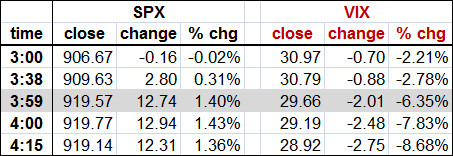
 .
.













